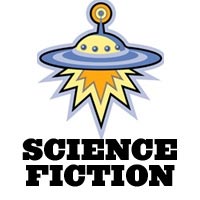The Flood of Alien Monster Films:
The 'alien monster' gimmick was profitable although many of
these 50s films were pure schlock. Sequels (of uneven quality) with more monstrous
creatures included:
 Creature
From the Black Lagoon (1954) - this was Jack Arnold's horror classic,
originally shot in 3-D; it was the last great classic from Universal Studios;
the second film in the trilogy was titled Revenge of the Creature (1955) and was set in a Florida marine park, with Clint Eastwood as a lab technician
in his screen debut; the third film was The Creature Walks Among Us (1956) from director John Sherwood; in the first film, a prehistoric, web-footed,
humanoid Gill-Man (Ben Chapman) was discovered swimming in a Brazilian river
in the Amazon by an anthropological expedition; included superb underwater
sequences with the creature's 'Beauty-and-the-Beast' interest in dark-haired
bathing beauty Julia Adams swimming above him in a white one-piece suit
that accentuated her breasts Creature
From the Black Lagoon (1954) - this was Jack Arnold's horror classic,
originally shot in 3-D; it was the last great classic from Universal Studios;
the second film in the trilogy was titled Revenge of the Creature (1955) and was set in a Florida marine park, with Clint Eastwood as a lab technician
in his screen debut; the third film was The Creature Walks Among Us (1956) from director John Sherwood; in the first film, a prehistoric, web-footed,
humanoid Gill-Man (Ben Chapman) was discovered swimming in a Brazilian river
in the Amazon by an anthropological expedition; included superb underwater
sequences with the creature's 'Beauty-and-the-Beast' interest in dark-haired
bathing beauty Julia Adams swimming above him in a white one-piece suit
that accentuated her breasts- director Lee Sholem's cheaply-made, kids-oriented Tobor
the Great (1954), looking like an old TV show, featured the first appearance
of a robot (Tobor is 'robot' spelled backwards!) in a 50s film
- It Came From Beneath The Sea (1955), about a giant
squid-octopus (with six tentacles to make it easier to animate) threatening
San Francisco and the Golden Gate Bridge; again with special effects by
Ray Harryhausen
- director Jack Arnold's 'giant-insect' film Tarantula
(1955), about a rampaging, 100 ft. high spider on
 the
loose in the Arizona desert (with the tagline: "See its mandibles crush
cars like tin cans!"); with Leo G. Carroll as a biochemist, and John
Agar and Mara Corday (Playboy's Miss October 1958); the film featured an
early and slight role for Clint Eastwood as an Air Force jet fighter pilot
who dropped burning napalm on the arachnid the
loose in the Arizona desert (with the tagline: "See its mandibles crush
cars like tin cans!"); with Leo G. Carroll as a biochemist, and John
Agar and Mara Corday (Playboy's Miss October 1958); the film featured an
early and slight role for Clint Eastwood as an Air Force jet fighter pilot
who dropped burning napalm on the arachnid
- director Bert Gordon's schlocky Beginning of the End
(1957), about radiation-generated, giant mutant grasshoppers with oversized
mandibles attacking parts of Illinois and Chicago's Wrigley Building
- The Black Scorpion (1957), about the unearthing
and unleashing of prehistoric giant scorpions in an exploding volcano in
Mexico; with stop-motion special effects from legendary Willis O'Brien (of King Kong fame) - his last theatrical feature
- The Giant Claw (1957), a cheesy sci-fi film about
an enormous winged bird (the Claw) from outer space that terrorized innocent
peasants in Northern Canada, and then destroyed the United Nations building
while flying southward
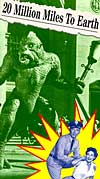 Nathan
Juran's The Deadly Mantis (1957), about a sleeping, gigantic, carnivorous
green praying mantis, frozen in the Arctic, that was resurrected by a volcanic
eruption, and threatened the destruction of both New York City and Washington,
DC Nathan
Juran's The Deadly Mantis (1957), about a sleeping, gigantic, carnivorous
green praying mantis, frozen in the Arctic, that was resurrected by a volcanic
eruption, and threatened the destruction of both New York City and Washington,
DC - 20 Million Miles to Earth (1957), another 'creature-feature'
from Nathan Juran, this time with special effects stop-motion animation
from Ray Harryhausen and rear-projection Dynamation, about a gelatinous
mass (growing into a reptilian biped called the Ymir) inadvertently brought
back on a returning American spaceship from Venus that crashed in the Mediterranean
near Sicily; the giant Venusian creature then threatened the city of Rome
and met its fiery fate in the Colosseum
- director Irving S. Yeaworth, Jr.'s campy The Blob (1958),
a typical combination of 50's teen film and sci-fi outer space creature
film; featured 28 year old Steve McQueen in his debut film role as a delinquent,
misunderstood high-schooler who witnessed the arrival of a meteor that oozed
a pink substance; a sequel Beware! the Blob (1972) (aka Son of
Blob) was directed by actor Larry Hagman (of Dallas TV fame)
and advertised as "The Film That J.R. Shot"
- It! The Terror From Beyond Space (1958), the inspirational
pre-cursor to Ridley Scott's Alien years
later;
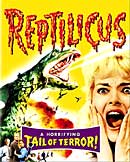 set
in the far-off future of 1964, about a spaceship that returns to Earth from
Mars with an additional savage, alien killer life-form (a rubber-suited
monster) on board set
in the far-off future of 1964, about a spaceship that returns to Earth from
Mars with an additional savage, alien killer life-form (a rubber-suited
monster) on board
- Ib Melchior's cult film The Angry Red Planet (1959) told of a fateful and deadly expeditionary trip to Mars, in which four crew
members faced devouring and dangerous creatures, including a man-eating
plant (a multi-tentacled Venus fly-trap), a giant crab-bat-rat-spider hybrid,
and a huge, ambulatory amoeba-like jellyfish creature - notably, the film
was made with a special-effects optical process called "Cinemagic"
that created a 3-D depth effect and tinted the Martian landscape reddish
- Edgar Ulmer's two quickly-made, low-budget films, the time-travel
film Beyond the Time Barrier (1960), and The Amazing Transparent
Man (1960), about a mad scientist who made a crook invisible in order
to steal radioactive materials and rob banks; filmed at the Texas State
Fair Showgrounds
- Dinosaurus! (1960), from Irving S. Yeaworth, Jr.,
advertised as "Alive with Thrills That Started 4 Million Years Ago",
with prehistoric dinosaurs (a Tyrannosaurus Rex and a brontosaurus) and
a Neolithic caveman revived by lightning in the Pacific
- Reptilicus (1962), an unsuccessful co-Danish-American
entry in the giant dinosaur-creature cycle; about the discovery
of a large prehistoric fossil reptile buried for years in ice in
Denmark, and its regeneration into a serpentine-like dragon monster
with armor-clad skin
Japan's Giant Monster Films:
Japan's Toho Studios (and director Inoshiro Honda, known as
"The Father of Godzilla") contributed to the "creature feature"
output after noticing the influence of Ray Harryhausen's The Beast From
20,000 Fathoms (1953) with stop-motion animation. They released a trilogy
of films about a similar monster (and an additional feature film), inevitably
followed by numerous other schlocky, dubbed sequels. This and subsequent Japanese
monster movies would feature actors in giant, rubber monster costumes, fake-looking
miniatures, and double-exposure photography:
- Gojira (1954, Jp.), d. Inoshiro Honda, about
an ancient, monstrous, fire-breathing (with radioactive breath), 400 foot
reptilian Asian creature aka Gojira (a melding of the words gorilla
and kujira, which means whale) - a mutant dinosaur (actually an actor
in a lizard suit terrorizing a miniature city) brought back to life from
the ocean depths to terrorize Tokyo after underwater nuclear testing; made
only a decade after the country's devastating experience with nuclear fallout
from Hiroshima and Nagasaki and during a time of underwater nuclear testing,
with the monster representing the atomic bomb and all of its destruction [Note: a newly-restored 'director's cut' of this
film was released in 2004, with 40 minutes of footage not previously shown,
and subtitles.]
- Godzilla Raids Again (1955, Jp.) (aka Gigantis The Fire Monster (1959)) - see below
- Sora no Daikaijuu Radon (1956, Jp.), (aka Rodan
(1956) and Monster of the Sky Rodan or Radon the Flying Monster),
director Inoshiro Honda's first film in color - about a giant, flying pterodactyl
monster that threatens to ravage the world
- Chikyuu Boeigun (1957, Jp.) (aka The Mysterians
(1957)), d. Inoshiro Honda and based upon the successful alien invasion
film The War of the Worlds (1953), without Gojira but featuring
a gigantic robot, and repeating the theme of the deadly after-effects of
nuclear radiation
- Battle in Outer Space (1959) (aka Uchu Daisenso (1959)),
d. Inoshiro Honda
- Mosura (1961, Jp.) (aka Mothra (1961)), d.
Inoshiro Honda, about a giant female caterpillar moth that destroys Tokyo
- King Kong vs. Godzilla (1962), another entry from
director Honda and Toho Studios - see below
The first Gojira sequel was director Motoyoshi Oda's Gojira no Gyakushu (1955, Jp.) (aka Godzilla's CounterAttack or Gigantis, The Fire Monster), that was released in the US in 1959
(directed by Hugo Grimaldi) as Godzilla Raids Again (1959, US) (aka Gigantis and The Return of Godzilla).
 Godzilla,
King of the Monsters (1956, US), d. Terrell O. Morse, was the US remake
of Honda's original 1954 film, released by producer Joseph E. Levine and his
Transworld Pictures. It was a very different, butchered and Americanized film
for US audiences (without most of the anti-nuclear political statements and
references to the dangers of the H-bomb), with 40 minutes excised and 20 minutes
of new footage. The poorly-dubbed film featured American actor Raymond Burr
as an American reporter who pleads with a scientist named Dr. Kyohei Yamane
(Takashi Shimura) to challenge the monstrous dinosaur with his invention -
an 'oxygen destroyer.' This film was remade as a Hollywood blockbuster by
Roland Emmerich, titled Godzilla (1998), starring Matthew Broderick
and featuring a computer-generated monster. Godzilla,
King of the Monsters (1956, US), d. Terrell O. Morse, was the US remake
of Honda's original 1954 film, released by producer Joseph E. Levine and his
Transworld Pictures. It was a very different, butchered and Americanized film
for US audiences (without most of the anti-nuclear political statements and
references to the dangers of the H-bomb), with 40 minutes excised and 20 minutes
of new footage. The poorly-dubbed film featured American actor Raymond Burr
as an American reporter who pleads with a scientist named Dr. Kyohei Yamane
(Takashi Shimura) to challenge the monstrous dinosaur with his invention -
an 'oxygen destroyer.' This film was remade as a Hollywood blockbuster by
Roland Emmerich, titled Godzilla (1998), starring Matthew Broderick
and featuring a computer-generated monster.
Inoshiro Honda's trilogy of monster films spawned new giant
monsters, such as Majin (a monster of terror), Gamera (a jet-propelled flying
turtle), Barugon (a gigantic lizard), Ghidrah (a three-headed dragon), Dagora
(flying jellyfish) as well as Godzilla clones named Agon and Gappa. The sequels
were often battles of elimination, including King Kong vs. Godzilla (1962), Godzilla vs. Mothra (1964) (aka Godzilla vs. The Thing), Ghidrah:
The Three-Headed Monster (1964), Godzilla vs. Monster Zero (1965) (aka Monster Zero), Destroy All Monsters (1968), and Godzilla's
Revenge (1969) (aka All Monsters Attack). The Japanese Godzilla
monster would later return in the mid-80s as Gojira (1984) (aka Godzilla
1985: The Legend is Reborn) - a remake of the 1956 classic, in the mid-90s
as Godzilla vs. Destoroyah (1995), and at the turn of the century with Godzilla 2000 (1999) (the first Japanese Godzilla movie since
the 1985 installment to receive a US theatrical release). Toho's franchise
of Godzilla films totaled almost 30 films in all. The ultimate films in the
US series were Roland Emmerich's big-budget Godzilla (1998), and the
50th Anniversary film Godzilla: Final Wars (2004) - reprising the giant monster's battles with many of its old foes.
The Giant Mutated Monster and Giant People Films of Bert
I. Gordon (1957-1977):
The famed schlockmeister B-director Bert Gordon (nicknamed
Mr. Big, whose initials were B.I.G.) specialized in cheesy "giant mutated
monster and giant people" films with cheap special effects, many of which
were lampooned on the TV series Mystery Science Theater 3000. His most
famous film was The Amazing Colossal Man (1957), about Army Lt. Colonel
Glenn Manning (Glenn Logan), who in a futile attempt to save a downed pilot,
was blasted by a plutonium bomb, and grew to the height of 50 feet as a bald
giant and then rampaged through Las Vegas, where he fell off Hoover/Boulder
Dam to his apparent death. (It was followed by an inferior sequel War of
the Colossal Beast (1958), notable only as a B/W film with a color finale
when the Beast was electrocuted.) Other notable Gordon films included the
giant grasshopper film Beginning of the End (1957) (that resembled Them! (1954)) and starring Peter Graves, Earth Vs. the Spider (1958) (remade as a 2001 TV movie), a beach-party rock 'n' roll monster film Village
of the Giants (1965) starring young Beau Bridges, Ron (as Ronny) Howard,
Tommy Kirk and Johnny Crawford, The Food of the Gods (1976), and Empire
of the Ants (1977) about giant marauding mutated ants in backwater
Florida.
Britain's 50s Quatermass Series:
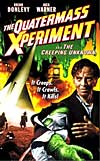 By
mid-century, Britain's Hammer Studios' also produced some pioneering sci-fi
films, adapted from the BBC-TV's earlier six-part serials or mini-series between
1953 and 1960, each written by Nigel Kneale: By
mid-century, Britain's Hammer Studios' also produced some pioneering sci-fi
films, adapted from the BBC-TV's earlier six-part serials or mini-series between
1953 and 1960, each written by Nigel Kneale:
- The Quatermass Xperiment (aka The Creeping Unknown)
(1956), told of a rocket launched into space with three
astronauts; when the rocket crash landed back in England, at
the scene was American rocket scientist Professor Bernard Quatermass
(Brian Donlevy); the only astronaut found returning in the capsule
was Victor
Carroon (Richard Wordsworth), who now had the special ability
to absorb any living thing into his body- he was turning into,
transforming or mutating into a monster due to the alien creature
that had 'infected' him. Endangering Earth, Carroon was electrocucted
in the film's climax. [The film inspired - or was copied by
- The
Blob (1958).]
- Quatermass 2 (aka Enemy From Space) (1957),
a chilling alien invasion sequel to the original film; Earth was
threatened with an invasion carried out by a multi-cellular brain
creature; Professor Quatermass (Donlevy again) was called upon
to investigate a huge mysterious scientific plant being constructed
where hollow meteorites were landing (and harboring an ammonia-based
gas that caused V-shaped lesions on people's faces); the plant
with zombie-like guards was supposedly producing synthetic food
- a cover-up for a deadly alien take-over of the local population
and government, that invaded the bodies of humans and controlled
their minds as a single organism.
- Quatermass and the Pit (aka Five Million Years
to Earth) (1968), the third in the trilogy, coming 10 years
after the last film; with more threats to London after workers
uncovered another strange discovery - a buried alien Martian
spacecraft (nearly 5 million years old) near the construction
site of a London Underground extension; the finding haunted anthropologist
Professor Quatermass (Andrew Keir); it was deduced that the
craft, containing human skeletons and 'locust-like' devil
creatures, was causing powerful psychic disturbances and unleashing
dormant powers, and was a key to humanity's ancient history
- a later sequel, Quatermass Conclusion (1979) was
comprised of condensed highlights from the 4-hour British TV serial
(4 episodes, each 60 minutes in length)
Verne and Wells Derivatives:
Many SF films were (and still are) a futuristic combination
of the work of visionaries Jules Verne and H. G. Wells (1866-1946).
One of the earliest adapted US/Hollywood science fiction films was Mysterious
Island (1929) - the filmed version of Jules Verne's
19th century novel with a Lost Atlantis theme. Other Verne adaptations
(some not in the sci-fi genre) reached their peak in the 50s and
60s, and included:
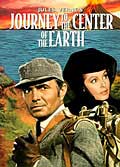 20,000
Leagues Under the Sea (1954), both a 1916 silent version and Disney's
version, about Captain Nemo aboard an advanced submarine; also an animated
version in 1990 20,000
Leagues Under the Sea (1954), both a 1916 silent version and Disney's
version, about Captain Nemo aboard an advanced submarine; also an animated
version in 1990- producer Michael Todd's episodic, all-star adventure
film extravaganza Around
the World in 80 Days (1956)
- From the Earth to the Moon (1958), about a rocket
trip to the moon, starring Joseph Cotten, George Sanders, and Debra Paget
- Journey to the Center of the Earth (1959), based
on Verne's 1864 novel, a fascinating exploration into the earth's core by
way of an Icelandic volcano, led by a Victorian scientist (James Mason)
and a star-studded group of travelers
- the fantasy-adventure Mysterious Island (1961) about
two escaping Civil War prisoners whose flying balloon landed on an unusual
Pacific island populated by threatening, gigantic animals and more (with
spectacular Ray Harryhausen special effects)
- Master of the World (1961), with a mad-scientist
who wanted to rule the world plot, starring Vincent Price and Charles Bronson;
also appeared in an animated version in 1976
- director Irwin Allen's Five Weeks in a Balloon (1962),
an adventure tale of a 19th century British explorer who conducted a ballooning
expedition to Africa
- In Search of the Castaways (1962), based on Verne's
novel Captain Grant's Children
H.G. Wells' books also provided material from which to compose
film adaptations, such as:
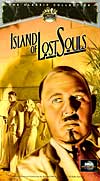 The
Island of Lost Souls (1933), the original classic with Charles Laughton
(in his first starring US role) as a disturbed, fugitive mad doctor (similar
to Dr. Frankenstein) on a remote tropical island who experimentally turned
beastly jungle animals into half-human-like creatures; British censors banned
the film, claiming it was "against nature"; the film was remade
twice with Wells' original book title The Island of Dr. Moreau -
in 1977 with Burt Lancaster as the sinister scientist, and director John
Frankenheimer's version in 1996 with Marlon Brando in the title role The
Island of Lost Souls (1933), the original classic with Charles Laughton
(in his first starring US role) as a disturbed, fugitive mad doctor (similar
to Dr. Frankenstein) on a remote tropical island who experimentally turned
beastly jungle animals into half-human-like creatures; British censors banned
the film, claiming it was "against nature"; the film was remade
twice with Wells' original book title The Island of Dr. Moreau -
in 1977 with Burt Lancaster as the sinister scientist, and director John
Frankenheimer's version in 1996 with Marlon Brando in the title role- a classic mad science film, James
Whale's The Invisible Man (1933), see above
- Things to Come (1936), see above
- Alexander Korda's sci-fi fantasy The Man Who Could Work
Miracles (1937), with Roland Young as a mild-mannered and timid department
store clerk who suddenly became omnipotent
- the classic alien invasion film The War of the Worlds
(1953), based upon Wells' 1898 novel, see above; [remade in director
Steven Spielberg's War of the Worlds (2005)]
- the classic time travel film The Time Machine (1960),
based upon Wells' 1895 novel, see further below
- The First Men in the Moon (1964), a tale
of turn-of-the-century lunar explorers; the film was noted for Ray Harryhausen's
wonderful special effects
- The Food of the Gods (1976)
|
